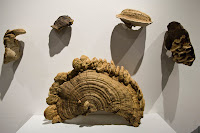
On March 16, we attended an Intimate Science Get Together at Real Art Ways in Hartford, featuring Phil Ross and our own myco-friend, Connie Borodenko. It was advertised as "A conversation on fungus as artistic medium and sustainable architectural material", and featured physical examples of the building bricks fashioned by Mr. Ross from the mycelium of reishi mushrooms, Ganoderma lucidum.
Connie was the opening speaker, talking about her family history of mushroom hunting and her own experiences with Connecticut Valley Mycological Society. She also helped answer questions from the audience about nutritional value and medicinal value of some of the fungi we find here in Connecticut. Connie also provided some samples of local conks, just about the only fungi we can find in the middle of March.
 |
| Arches made from the mushroom bricks |
Philip Ross talked about his fabrication process with the mycelium of the medicinal reishi, and explained its connection to his previous background of working with critically ill AIDS patients in the 1980's. His interest in reishi as alternative medicine is what brought him to studying medical aspects of mushrooms, and eventually to home cultivation of mushrooms as food. He became interested in casting the mycelium from the growing fungi into architectural elements, controlling the organic growth and potential fruiting of the fungus with humidity, temperature, pressure, and light. He also discussed how the bricks and molded structures, if left "alive", can be coaxed to grow together with their own kind of organic glue, bridging gaps in structures and creating bonds between bricks.
 |
| Close up of a brick, showing evidence of fruiting, most of the mushrooms are removed for a uniform brick |
Mr. Ross presented many slides of his works, including small structures and furniture. Several examples of his molded bricks were on display, including a small arch and and some of the more artistic and organic pieces. He participated in a question and answer session after his presentation, and his patent for fungal bricks as sustainable, non-toxic building material was mentioned, however he was not willing to discuss potential partners in his endeavors to making the fungal blocks a commercial success. He was willing to share the facts that the bricks are excellent sound dampeners, and fire resistant as well as light weight. There is an excellent interview with Phil Ross over at Glasstire, an art blog, that I highly recommend, called The Future is Fungal. The interview goes into more depth about his inspirations and his own educational process, citing Paul Stamets as a source of information and his thoughts on the future of fungal education.
Many thanks to Connie for the invite out to the exhibition, it was also great to see other CVMS members in the audience to learn about the art of mushroom bricks.
 |
| Mycelial form allowed to "fruit"organically |




2 comments:
Wow, what a fascinating concept! Any idea as to how long they'll last structurally? That last picture of the wall - looks like it could be thousands of years old - very nice!
I don't know how long the bricks would last. I would think they need to be sealed, but they are super light and customizable since they can be "molded" and grown into whatever shape you want. The look is what makes it some beautiful art, and it just happens to be practical!
Post a Comment